Chert, a biochemical sedimentary rock, owes its composition to microcrystalline quartz. It possesses exceptional hardness, scoring a 7 on the Mohs hardness scale, and exhibits the distinctive trait of conchoidal fracturing. Chert’s color palette knows virtually no bounds, although it often manifests as shades of gray, brown, red, or green. Its family tree comprises numerous subvarieties, including flint, jasper, agate, and onyx.
While chert comprises a distinct rock category, pinpointing whether a rock you’ve encountered is indeed chert can prove challenging. This complexity arises from the myriad subvarieties, each with its unique appearance that can diverge significantly from others. Chert often teeters on the edge of confusion with closely related rocks. In the following sections, I’ll guide you through the art of identifying chert, illuminating the distinguishing features of its diverse subtypes, and unveiling the locales where it can be unearthed.
What Does Chert Look Like?
Chert comes in so many distinct varieties that it can be difficult to describe what it looks like. One piece of chert might look almost entirely different from the next, depending on how it was formed and what impurities are present. Still, there are general attributes that practically all cherts share if you know what to look for.
In general, chert looks like a mass of sediment with relatively smooth, waxy-looking surfaces. It displays conchoidal fracturing resulting in very sharp edges. Chert can be almost any color but is most commonly grey, brown, reddish, or light green. Most varieties are opaque, but it can also be translucent.
While all chert fits this general description, there is still quite a bit of variability from specimen to specimen. Because there is so much variation, it is perhaps easiest to briefly describe what each individual type looks like. Each of these varieties forms in a slightly different way, and it can have a drastic impact on what the final rock looks like.
Common Varieties of Chert
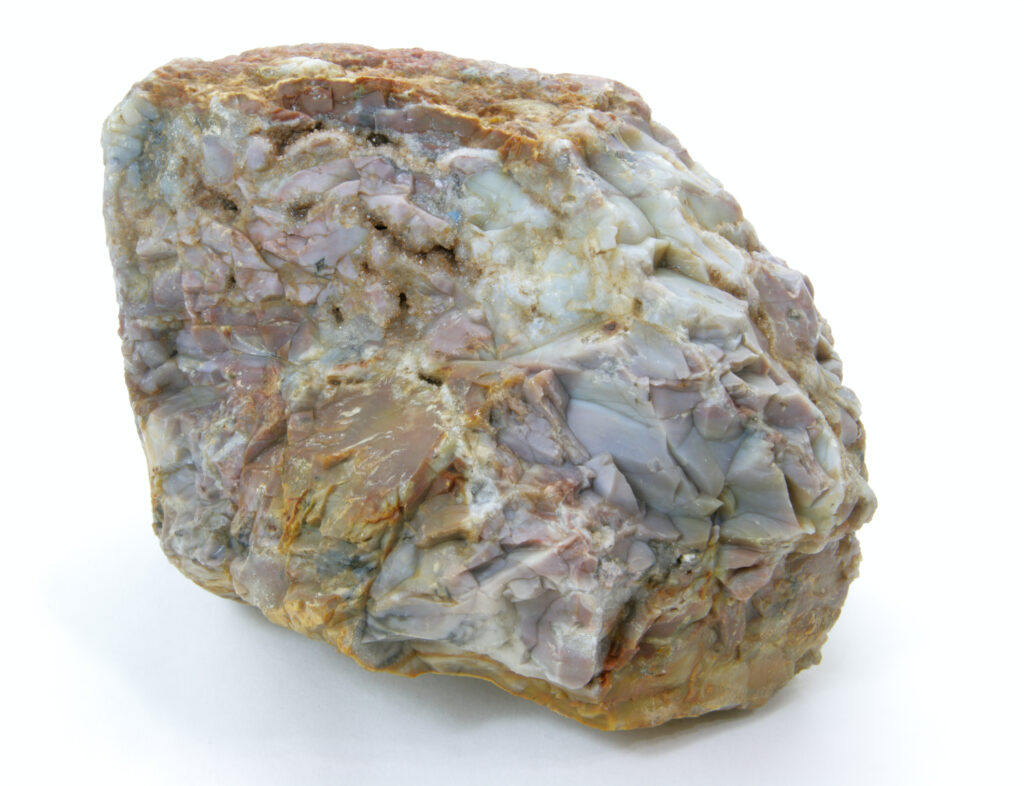
Common Chert
Normal, common chert is opaque and usually greyish or brownish, but can also have shades of red, green, and blue. It displays conchoidal fracturing the result in sharp edges. It is otherwise fairly nondescript, with no apparent banding. It often forms in limestone layers and is the most common form of chert.
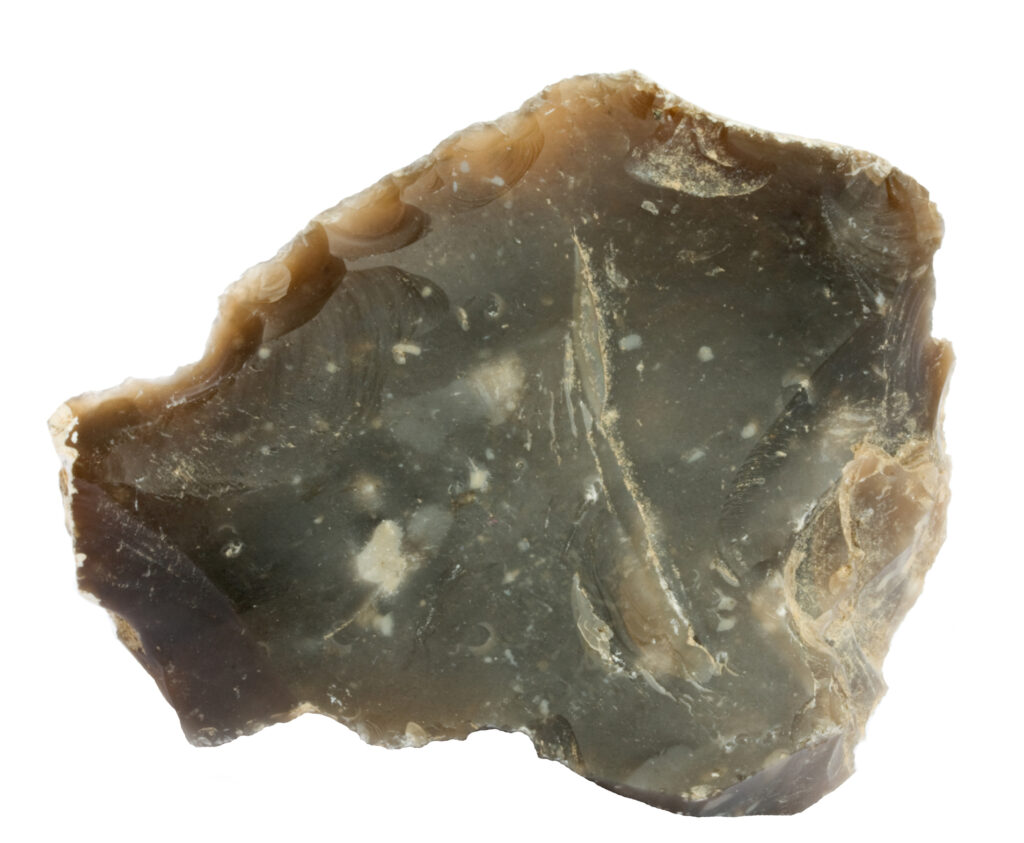
Flint
Flint is very similar to common chert in most respects, but it is often distinguished by geologists and collectors for its quality and coloration. Flint is considered to be higher-grade material and is almost always dark gray or black due to organic impurities. It has historically been used to make sharp tools like knives and arrowheads.
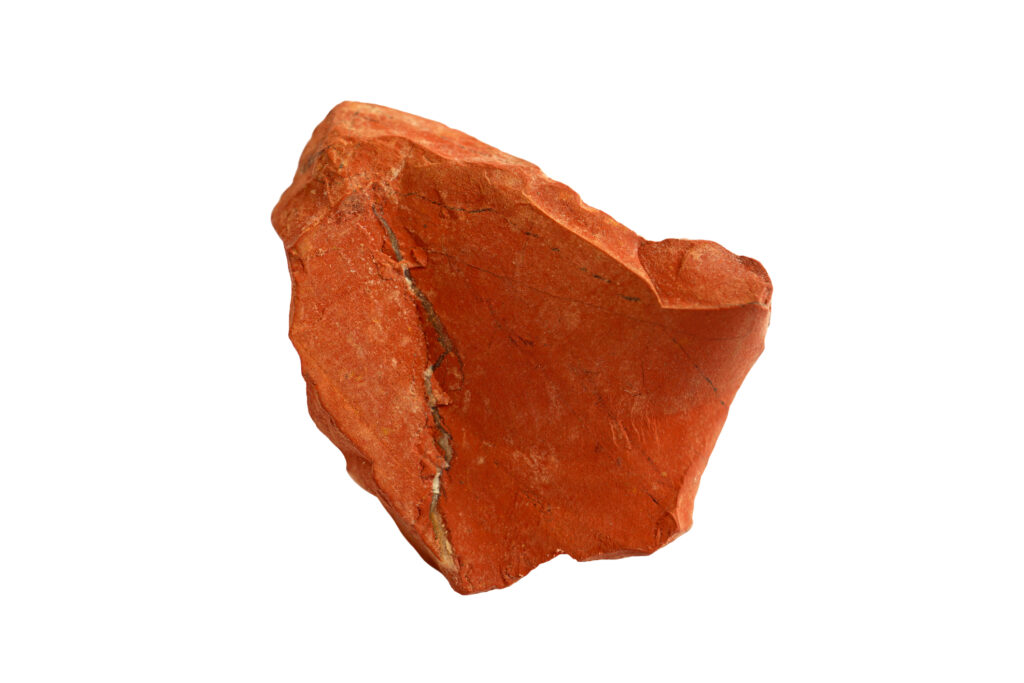
Jasper
Jasper is an opaque variety of chert that forms in association with igneous rocks. It forms in the void spaces of lava flows and gets its red coloration from impurities like iron and hematite. It is very popular with collectors for its bright colors, and it comes in many subvarieties itself. Jasper can sometimes grade into agate, which is sometimes referred to as jasp-agate.
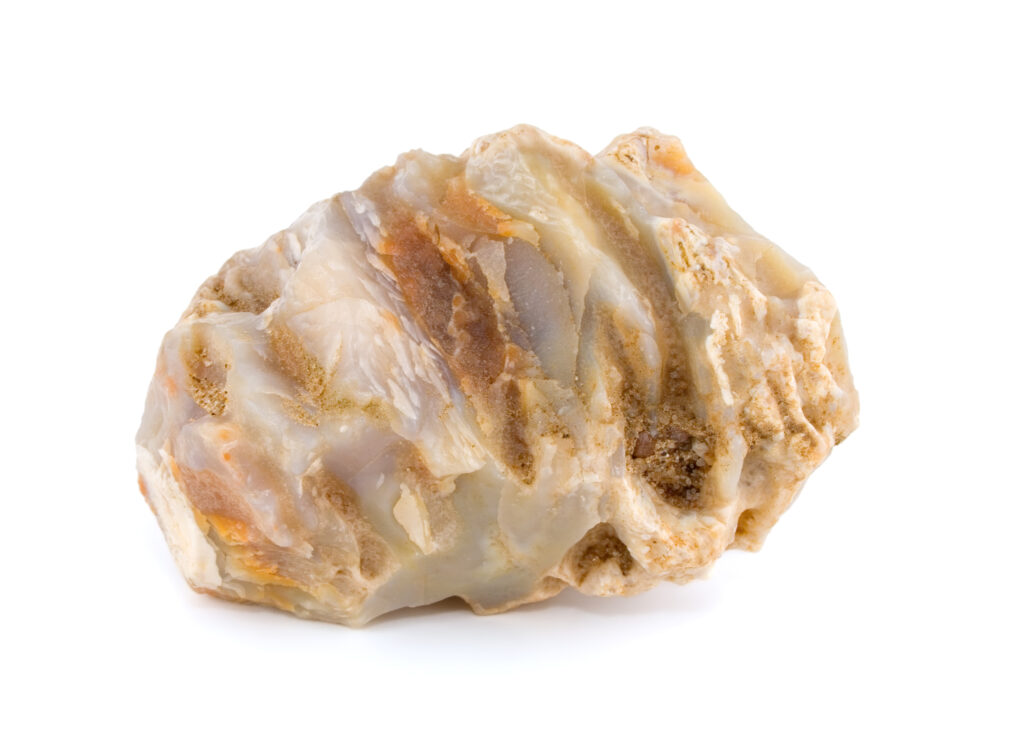
Chalcedony
Chalcedony is very similar to common chert, but is usually distinguished by its translucency. If you hold a light behind a piece of chalcedony you’ll be able to see the light shining through. Chalcedony is almost always off-white or otherwise lightly colored. It is common for chalcedony and chert to be intermixed with one another.
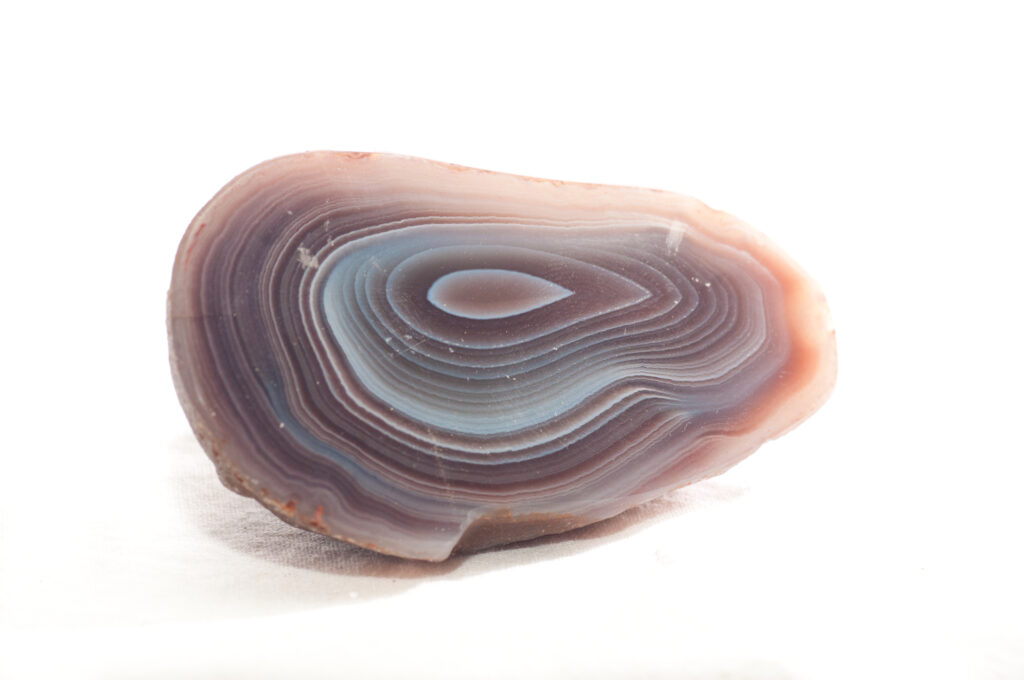
Agate
Exploring the World of Agate
Agate, a distinctive subvariety of chalcedony, shares the inherent trait of translucence with all chalcedony stones. However, what sets agate apart is its captivating and vibrant banding patterns, rendering it a coveted treasure among collectors. Often polished or meticulously cut to showcase its mesmerizing alternating bands of color, agate boasts a rich diversity of varieties, each possessing its unique characteristics and hues.
While there exists a plethora of chert varieties beyond those mentioned here, the ones highlighted are among the most prevalent and ardently sought after by enthusiasts. These varieties can be further classified based on factors such as coloration, banding patterns, geographical origins, and more. However, delving into these intricate details falls beyond the purview of this article.
The remarkable diversity observed in chert primarily arises from two fundamental factors: impurities and crystal growth habits.
Color is Driven by Impurities
Chert is, by definition, made almost entirely of microcrystalline quartz – the mineral version of SiO2. Pure quartz is almost completely transparent, so if chert were made of pure microcrystalline quartz you’d be able to see through it like glass.
But we know that’s not the case with almost any piece of chert found in nature. This is because chert is laden with impurities in the form of trace elements, and each of these impurities contributes some coloration.
Some of the most common impurities in chert are iron, aluminum, manganese, sodium, and calcium. Organic material and water are also frequently included in the fabric of chert. Each of these impurities has a distinct color associated with it. For instance, enough iron will turn chert red, as seen in many varieties of jasper. Similarly, organic material will turn it dark gray or black as seen in flint.
Pro Tip: To get a better look at the crystals in your rocks and help with identification I highly recommend picking up a good geologist’s hand lens.
Translucent or Opaque: The Dual Factors at Play
You might be curious about what determines whether certain chert varieties are opaque or translucent. The answer, in fact, involves a two-pronged explanation, with both factors working in tandem.
The degree of translucence in chert is significantly influenced by the quantity and nature of impurities present within it. If the rock contains a substantial concentration of trace elements, particularly dark-hued ones like iron and organic compounds, it is more inclined to manifest as opaque. Conversely, a lower concentration of light-colored impurities tends to yield a transparent variety of chert, such as agate or chalcedony.
However, impurities, while noteworthy, do not singularly dictate chert’s diaphaneity—the property determining how light passes through a rock.
Chert consists of microcrystalline quartz, but not all microcrystalline quartz forms in the same manner. Although these minute crystals are imperceptible to the naked eye, their structure can vary. Sometimes they adopt a blocky form, while in other instances, they assume a more elongated or fibrous arrangement.
Translucent chert varieties like chalcedony and agate primarily comprise fibrous microcrystals, whereas opaque counterparts like flint and common chert predominantly consist of blockier crystals. This subtle difference has a profound impact on the ease with which light traverses through a chert specimen.
How to Identify Chert
By now you might be thinking that chert must be difficult to identify, especially with so many different-looking variations. But, in most cases, chert is pretty easy to recognize if you know what to look for. As with any rock, it is important to take a systematic approach when identifying chert and its variants.
Chert usually has a waxy luster, with conchoidal fracturing that results in sharp edges. All chert is very hard and cannot be scratched by steel. Some varieties are opaque, while others are translucent. It may be almost any color but is usually gray or brown, and sometimes displays alternating bands of color.
Conchoidal fracturing is a very good diagnostic characteristic when trying to identify chert. It looks like someone has scooped out part of the rock with a spoon, resulting in smooth, convex depressions on the surface of the rock. These shapes are usually lined with edges that can be very sharp, which is why chert and flint were so desirable for making tools like arrowheads and primitive knives.
Your rock may not display clear conchoidal fracturing. There are also some other rock types (like obsidian) that fracture conchoidally but aren’t chert. Therefore, some additional tests and observations are often useful.
A simple hardness test is one of the best ways to check for chert. Since it is almost entirely made of quartz, chert is exceptionally hard – registering a 7 on the Mohs hardness scale. This is harder than steel! Use a steel nail and try to scratch your rock. If it doesn’t leave a scratch, then your rock is very hard (most likely quartz) and could potentially be chert.
Since chert is made of silica (quartz) and not calcite or dolomite it will not react with acid. If you’ve already performed a hardness test and your rock is harder than steel, it is not even necessary to conduct this test since both calcite and dolomite are much softer than steel.
In summary, a rock must meet all of these requirements to be considered chert:
- Chemical or Biochemical – A sedimentary rock formed from the solidification of microscopic silica particles
- Very Fine-grained – Individual grains are too small to see, even with a hand lens
- Very Hard – Cannot be scratched by steel (7 on the Mohs hardness scale)
Beyond that, the many varieties of chert almost need to be identified seperately. The opaque varieties like flint and common chert usually have a waxy appearance. The translucent varieties like agate and onyx usually display colorful banding. Once you see each variety a few times they become very easy to identify, especially with the aid of the simple tests described above.
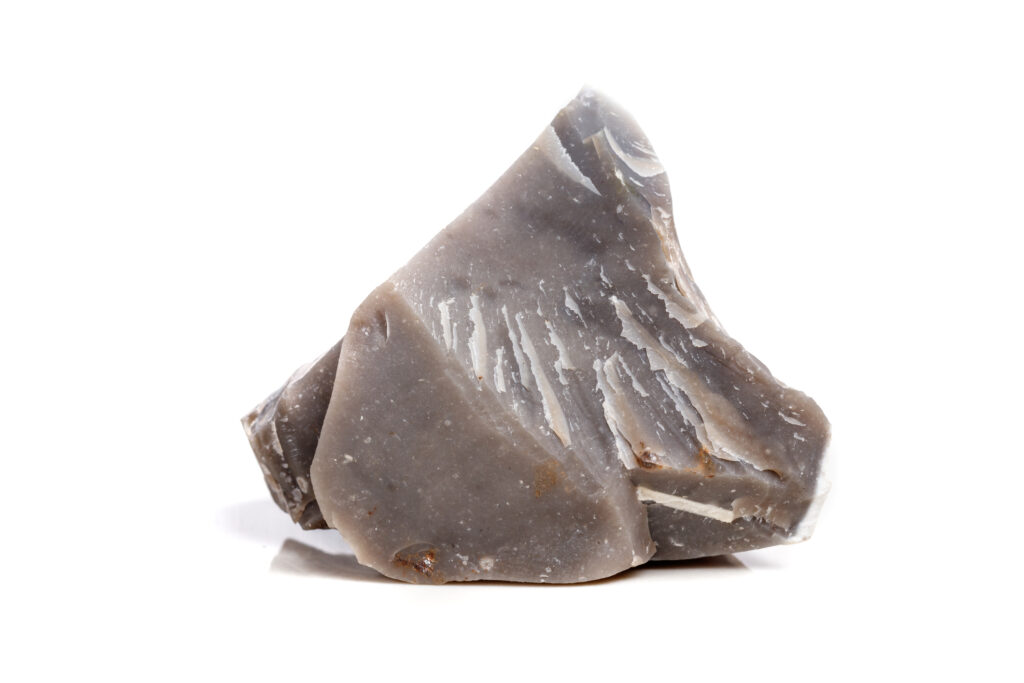
If your rock meets all of those criteria then it is very likely chert, or at least something very closely related. There are, however, a few closely related rocks that people sometimes confuse for sandstone.
- Obsidian – Might be confused for chert or flint due to smooth texture and conchoidal fracturing. Softer than chert, with a glassier texture.
- Micrite – Similar texture and color to chert and also sedimentary in origin, but much softer than chert and it reacts with acid.
- Crystalline Quartz – Same hardness as chert, but is one large, single crystal with defined, flat faces. Usually translucent or transparent.
The Composition of Chert Unveiled
The question of what precisely constitutes chert may initially appear straightforward, as we touched upon it earlier in this article—chert is composed of microcrystalline quartz, correct? However, the true answer can delve deeper into complexity. So, let’s delve into what chert is truly comprised of.
Broadly speaking, chert is primarily composed of microcrystalline or cryptocrystalline quartz, the mineral SiO2 in its diminutive crystalline form. These minuscule quartz crystals amalgamate to create a solid, glassy mass. Various chert varieties also encompass impurities in the guise of trace elements such as aluminum and iron, as well as organic matter or water content.
The microscopic quartz crystals frequently trace their origins to the hardened, fossilized remnants of organic sediment that settled on the ocean floor. Certain marine organisms, both past and present, leave behind minuscule siliceous shells upon their demise. These remnants serve as the fundamental constituents of biochemical chert, believed to be the predominant mechanism of chert formation.
In cases of biochemical chert formation, it is technically a conglomerate primarily constituted of diminutive fossils. While these fossils are imperceptible to the naked eye and necessitate high-powered magnification for observation, they undeniably represent fossils. Organisms such as diatoms and radiolarians secrete shells composed of silica, as opposed to the calcite shells characteristic of most familiar seashells.
However, chert can also emerge from the precipitation of minute quartz crystals out of water. For instance, a substantial portion of petrified wood originates from various chert varieties. This transformation transpires as the porous woody material undergoes a gradual replacement by silica suspended within circulating groundwater. In such cases, chert predominantly comprises microscopic quartz crystals and a few impurities.
Though it is plausible for chert to encapsulate relatively large fossils like seashells and coral, such occurrences are relatively infrequent. When present, they are typically found in biochemical cherts. Visible fossils within chert are less prevalent compared to other sedimentary rock types, such as limestone and sandstone.
Where Is Chert Found?
By now you are probably asking yourself where you can find some chert of your own. Or maybe you’ve already found a rock that you suspect might be chert and you’re wondering if it occurs in your area. Chert is a fairly common rock type and it occurs in locations all around the globe, but it helps to know the general settings in which it can be found.
In general, chert is found interbedded with shale and limestone, either as continuous beds or as nodules. Some inorganic varieties of chert like jasper and agate are more likely to be found in areas with a history of volcanism. Still more varieties may be found near hot springs and in banded iron formations.
Biochemical chert, formed from the collection and solidification of tiny silica fossils at the bottom of the ocean, is most likely to be found in areas with a geologic history of low-energy marine environments like deep ocean water. These same environments are prone to creating shale, so it is common to find chert beds associated with shale.
You can look for chert formations near you using this excellent interactive map from the USGS.
Usually, you’ll find chert formations near other sedimentary rocks like limestone, mudstone, and shale. These rocks tend to form in cycles and groups related to the relative water levels at the time of deposition.
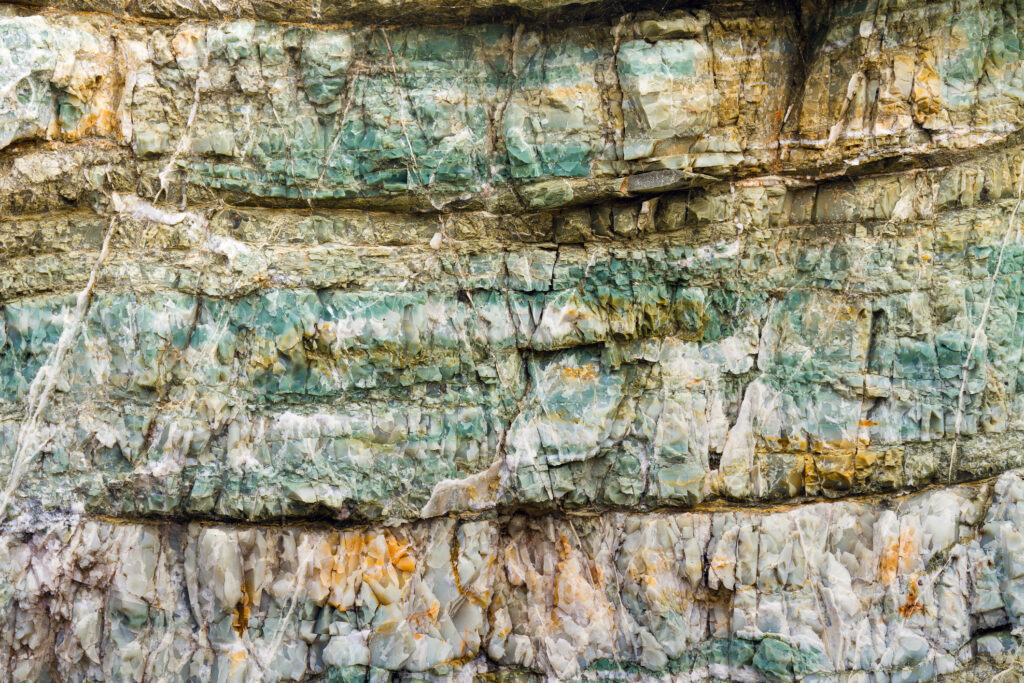
How Does Chert Form?
We’ve learned all about what chert looks like, what it is composed of, and generally where it’s found, but I have only briefly touched on how it’s actually formed. The creation of chert is not all that straightforward. It can actually occur in multiple ways, but always follows a few simple rules.
Most chert forms when large quantities of microscopic skeletons made of quartz fall to the ocean bottom, rapidly become buried and are gradually cemented together. Other varieties form when silica precipitates out of solution and replaces existing structures, such as nodules or petrified wood.
The processes by which chert form are actually quite complicated and sometimes not well understood. Many of the microscopic fossil types that form biochemical chert are thought to originally be made of opal (a hydrated version of microcrystalline quartz) which is later transformed into silica.
For chert types like agate and jasper, the process is quite different. They usually form in the old gas bubbles of basalt flows, and are therefor usually roughly spherical in shape. Silica-laden water slowly seeps through the rock and enters these voids, gradually leaving behind silica and filling up them up. Small changes in the chemistry of the water are responsible for the changes in color you see in banded agates.
What Is Chert Used For?
Chert has a long history of practical use all around the world, and continues to be popular for many reasons even today.
Chert has historically been used for practical tools like knives and arrowheads due to its conchoidal fractures and sharp edges. Flint has also long been used as a primitive means to start fires. High quality varieties of chert like flint, jasper, and agate remain popular materials for jewelry and decoration.
Agate in particular is a really fun rock to work with. It is probably the most popular rock type for lapidary artists and for tumbling because of its brilliant patterns and its ability to accept a nice polish.
You don’t usually see chert used for construction or building purposes. It doesn’t usually occur in large enough quantities to facilitate building stones, and there are problems with its chemistry and tendency to fracture that make it impractical to use even as aggregate or filler material.
